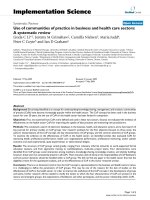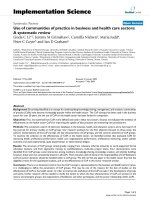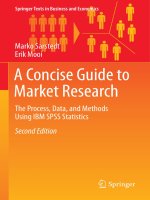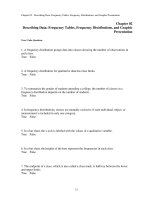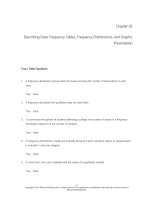Lecture Statistical techniques in business and economics - Chapter 5: A survey of probability concepts
Bạn đang xem bản rút gọn của tài liệu. Xem và tải ngay bản đầy đủ của tài liệu tại đây (2.64 MB, 58 trang )
5 1
A Survey of
Concepts
Copyright © 2004 by The McGrawHill Companies, Inc. All rights reserved.
5 2
When you have completed this chapter, you will be able to:
1
Explain the terms random experiment,
outcome, sample space, permutations,
and combinations.
2
Define probability.
3
4
Describe the classical, empirical, and subjective
approaches to probability.
Explain and calculate conditional probability
and joint probability.
Copyright © 2004 by The McGrawHill Companies, Inc. All rights reserved.
5 3
5
Calculate probability using the rules of
addition and rules of multiplication.
6
Use a tree diagram to organize and
compute probabilities.
7
Calculate a probability using Bayes’ theorem.
Copyright © 2004 by The McGrawHill Companies, Inc. All rights reserved.
Types of Statistics
Types of Statistics
Descriptive
Descriptive
Methods of…
collecting
organizing
presenting
and
analyzing data
Copyright © 2004 by The McGrawHill Companies, Inc. All rights reserved.
5 4
Inferential
Inferential
Science of…
Science of…
making inferences
making inferences
about a population,
about a population,
based on
based on
sample
sample
information.
information.
Emphasis now to be on this!
Emphasis now to be on this!
Terminology
5 5
Probability
…is a measure of the
…is a measure of the
likelihood that an event in the future will happen!
likelihood that an event in the future will happen!
It can only assume a value between 0 and 1.
A value near zero means the event is not
likely happen; near one means it is likely..
There are three definitions of probability:
classical, empirical, and subjective
Copyright © 2004 by The McGrawHill Companies, Inc. All rights reserved.
Terminology
5 6
Random Experiment
…is a process
…is a process
repetitive in nature
the outcome of any trial is uncertain
welldefined set of possible outcomes
each outcome has a probability
associated with it
Copyright © 2004 by The McGrawHill Companies, Inc. All rights reserved.
Terminology
5 7
…is a particular result of a
random experiment.
... is the collection or set of all
the possible outcomes of a
random experiment.
…is the collection of one or more
outcomes of an experiment.
Copyright © 2004 by The McGrawHill Companies, Inc. All rights reserved.
Approaches to Assigning Probability
5 8
ubjective
SSubjective
…probability is based on whatever information is available
…probability is based on whatever information is available
Objective
bjective
O
Classical
lassical PProbability
robability
C
… is based on the
is based on the
…
assumption that the
assumption that the
outcomes of an experiment
outcomes of an experiment
are equally likely
are equally likely
Empirical
mpirical P
Probability
robability
E
… applies when the number
… applies when the number
of times the event happens
of times the event happens
is divided by the number of
is divided by the number of
observations
observations
Probability
Probability
NUMBER of favourable outcomes
= Total NUMBER of possible outcomes
of an Event
an Event
of
Copyright © 2004 by The McGrawHill Companies, Inc. All rights reserved.
Examples
Examples
S ubjective
Probability
5 9
…. refers to the chance of occurrence
chance of occurrence
…. refers to the
assigned to an event
assigned to an event
by a particular individual
by a particular individual
It is not computed objectively
not computed objectively,
,
It is
i.e., not
not from prior knowledge or from actual
from prior knowledge or from actual
i.e.,
data…
data…
…that the Toronto Maple Leafs will win the Stanley
Cup next season!
…that you will arrive to class on time tomorrow!
Copyright © 2004 by The McGrawHill Companies, Inc. All rights reserved.
E mpirical
Probability
5 10
Students measure the contents of their soft
Students measure the contents of their soft
drink cans… 10 cans are underfilled,
drink cans… 10 cans are underfilled,
32 are filled correctly and
32 are filled correctly and
When the contents of the next can is measured,
When the contents of the next can is measured,
8 are overfilled
8 are overfilled
what is the probability that it is… (a) filled correctly?
what is the probability that it is… (a) filled correctly?
P(C) = 32 / 50 = 64%
…(b) not filled correctly?
…(b) not filled correctly?
P(~C) = 1 – P(C) = 1 .64 = 36%
This is called the Complement of C
Complement of C
This is called the
Copyright © 2004 by The McGrawHill Companies, Inc. All rights reserved.
Random Experiment
5 11
The experiment is rolling the die...once
once!!
The experiment is rolling the die...
The possible outcomes are the numbers…
1 2 3 4 5 6
An event is the occurrence of an even number
i.e. we collect the outcomes 2, 4, and 6.
Copyright © 2004 by The McGrawHill Companies, Inc. All rights reserved.
Tree Diagrams
5 12
This is a useful device to show all the possible outcomes
This is a useful device to show all the possible outcomes
of the experiment
of the experiment
and their corresponding probabilities
and their corresponding probabilities
Consider the random experiment of flipping
a coin twice.
Copyright © 2004 by The McGrawHill Companies, Inc. All rights reserved.
Tree Diagrams
Origin
First
Flip
SecondF
lip
H
H HH
T HT
H TH
T
T TT
5 13
Expressed as:
P(HH)= 0.25
P(HT)= 0.25
Simple Events
Simple Events
P(TH)= 0.25
P(TT)= 0.25
1.00
New
Copyright © 2004 by The McGrawHill Companies, Inc. All rights reserved.
Tree Diagrams
Origin
Menu
Appetizer:
Soup or Juice
Entrée:
Beef
Turkey Fish
Dessert:
Pie
Ice Cream
Appetizer
Entrée
Beef
Soup
Turkey
Fish
Beef
Juice
Turkey
Fish
5 14
Dessert
Pie
Ice Cream
Pie
Ice Cre am
Pie
Ice Cream
Pie
Ice Cream
Pie
Ice Cream
Pie
Ice Cream
Copyright © 2004 by The McGrawHill Companies, Inc. All rights reserved.
5 15
Tree Diagrams
How many complete dinners are there?
are there?
How many complete dinners
5 12
Tree Diagrams
O r ig in
Me nu
A p p e t iz e r :
S o up o r
J uic e
Ent r é e :
Be e f
T ur k e y
Fis h
De s s e r t :
Pie
I c e C r e am
A p p e t iz e r
Ent r é e
Be e f
S o up
T ur k e y
Fis h
Be e f
J uic e
Copyright © 2004 by The McGrawHill Companies, Inc. All rights reserved.
T ur k e y
Fis h
De s s e r t
Pie
I c e Cr e a m
Pie
I c e Cr e a m
Pie
I c e Cr e a m
Pie
I c e Cr e a m
Pie
I c e Cr e a m
12
12
5 16
Tree Diagrams
Tree Diagrams
How many dinners include beef?
How many dinners include beef?
O r ig in
A p p e t iz e r
Ent r é e
De s s e r t
Pie
Me nu
A p p e t iz e r :
S o up o r
J uic e
Ent r é e :
Be e f
T ur k e y
Fis h
De s s e r t :
Pie
I c e Cr e am
Be e f
S o up
T ur k e y
Fis h
Be e f
J uic e
Copyright © 2004 by The McGrawHill Companies, Inc. All rights reserved.
T ur k e y
Fis h
5 12
1.
I c e Cr e a m
2.
Pie
I c e Cr e a m
3.
Pie
I c e Cr e a m
4.
Pie
I c e Cr e a m
Pie
I c e Cr e a m
44
5 17
Tree Diagrams
What is the pprobability that a complete dinner will
robability that a complete dinner will
What is the
include…
include…
5 12
Tree Diagrams
O r ig in
Me nu
Appe t ize r :
S o up o r
J uic e
Ent r é e :
Be e f
T ur ke y
Fis h
De s s e r t :
Pie
I c e Cr e am
Appe t ize r
Ent r é e
Be e f
S o up
T ur ke y
Fis h
Be e f
J uic e
T ur ke y
Fis h
De s s e r t
Pie
I c e Cr e a m
Pie
I c e Cr e a m
Pie
I c e Cr e a m
Pie
I c e Cr e a m
Pie
I c e Cr e a m
Copyright © 2004 by The McGrawHill Companies, Inc. All rights reserved.
Juice?
6/12
6/12
Turkey?
4/12
4/12
Both beef
and soup?
2/12
2/12
See next
See next
slide…
slide…
e M * N Rule
h
T M * N Rule
5 18
If one thing can be done in M ways, and if
M ways, and if
If one thing can be done in
after this is done, something else can be
after this is done, something else can be
done in N ways, then
then
done in N ways,
both things can be done in a total
total of
of
both things can be done in a
M*N different ways in that stated order!
M*N different ways in that stated order!
Legend:
Legend:
Appetizer
Entrée
Dessert
Refer back to tree diagram example:
# different meals = 2 * 3 * 2 = 12
# meals with beef = 2 * 1 * 2 = 4
# meals with juice = 1 * 3 * 2 = 6
Copyright © 2004 by The McGrawHill Companies, Inc. All rights reserved.
5 19
When getting dressed, you have a
When getting dressed, you have a
choice between wearing one of:
choice between wearing one of:
3 pairs of shoes
3 pairs of shoes
2 pairs of pants
2 pairs of pants
5 shirts
5 shirts
Find the number of
Find the number of
different “outfits” possible
different “outfits” possible
3 * 2 * 5 = 30
Copyright © 2004 by The McGrawHill Companies, Inc. All rights reserved.
robability
5 20
What is the probability of
What is the probability of
drawing a red Ace
drawing a red Ace
from a deck of well
from a deck of well
shuffled cards?
shuffled cards?
P( Red Ace) = 2/52
Copyright © 2004 by The McGrawHill Companies, Inc. All rights reserved.
5 21
robability
Deck = 52 Cards
4 Suits
Clubs Diamonds Hearts
Spades
13 cards in each
Key steps
1.1.
2.2.
Using
robability Analysis
Determine….the Outcomes that Meet
Our Condition
List….all Possible Outcomes
Copyright © 2004 by The McGrawHill Companies, Inc. All rights reserved.
robability
P = probability
5 22
…of getting four(4) aces
Deck = 52 Cards(the Population)
4 Suits
Clubs Diamonds Hearts Spades
13 cards in each
Copyright © 2004 by The McGrawHill Companies, Inc. All rights reserved.
4 Suits
x
13 cards
5 23
robability
Deck = 52 Cards
4 Suits (13 cards in each)
Hearts
Spades Diamonds Clubs
Each Suit has a…….
Each Suit has a…….
‘Honours’
‘Honours’
cards
cards
Scenarios
Copyright © 2004 by The McGrawHill Companies, Inc. All rights reserved.
Deck = 52 Cards
Scenarios
4 Suits (13 cards in each)
Hearts
1. Draw an Ace
5 24
Spades Diamonds Clubs
Condition Outcomes
All Possible Outcomes
2. Draw a Black Ace Condition Outcomes
All Possible Outcomes
3. Draw a Red Card Condition Outcomes
All Possible Outcomes
Copyright © 2004 by The McGrawHill Companies, Inc. All rights reserved.
4
52
2
52
26
52
Deck = 52 Cards
Scenarios
4 Suits (13 cards in each)
Hearts
Spades Diamonds Clubs
4. Drawing…a Red Condition Outcomes
Card or a Queen All Possible Outcomes
or
5 25
26
52
+
2
52
P (Red) + P (Queen) - P (Red Queen)
28
=
26 +
4 - 2
= 52
52
Copyright © 2004 by The McGrawHill Companies, Inc. All rights reserved.
=
28
52

